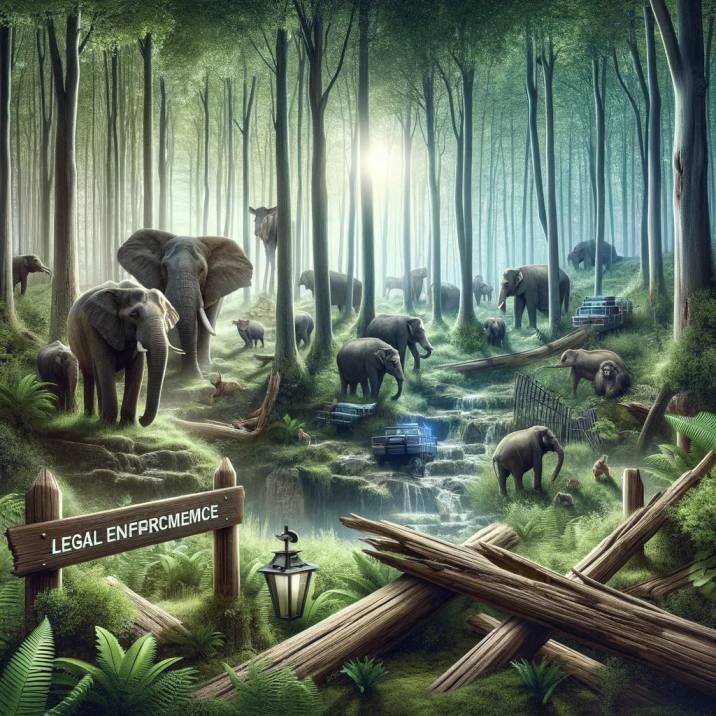This article will guide you about Protecting Wild Animals.India’s rich biodiversity is home to a vast array of wild animals, many of which are endemic and crucial to the ecological balance. Recognizing the importance of protecting these invaluable natural resources, India has established a comprehensive legal framework. This article delves into the rules and regulations under Indian law aimed at safeguarding wild animals, highlighting the key legislations, their provisions, and the challenges in enforcement.
Protecting Wild Animals: Understanding The Rules in Indian Law
The Wildlife (Protection) Act, 1972
At the heart of India’s wildlife protection efforts is the Wildlife (Protection) Act, 1972. This landmark legislation was enacted to provide for the protection of wild animals, birds, and plant species to ensure environmental and ecological security.
Key Provisions of the Act
- Prohibition of Hunting: The Act prohibits the hunting of animals listed in its various schedules, except under specific, regulated circumstances.
- Wildlife Trade Regulation: It controls the trade in parts and products derived from wildlife, making the trade of endangered species illegal.
- Establishment of Protected Areas: The Act allows for the creation of sanctuaries, national parks, and closed areas to provide safe habitats for wildlife.
Challenges in Enforcement
Despite its comprehensive scope, the Act faces challenges in enforcement, including poaching, habitat destruction, and the illegal wildlife trade. Strengthening patrol and surveillance in protected areas is crucial for overcoming these challenges.
Forest Conservation Act, 1980
The Forest Conservation Act, 1980, plays a significant role in wildlife protection by conserving forests and their biodiversity. It restricts the de-reservation of forests and conversion of forest land to non-forest purposes without the central government’s approval.
Importance for Wildlife Protection
- Habitat Conservation: By conserving forests, the Act indirectly protects the habitats of countless wildlife species, ensuring their survival and well-being.
- Regulation of Land Use: It ensures that forest land is not diverted for developmental activities that could harm wildlife habitats.
The Environment (Protection) Act, 1986
This Act complements wildlife conservation efforts by addressing environmental pollution and industrial impacts that could harm wildlife habitats.
Environmental Standards and Wildlife
- Setting Environmental Standards: It empowers the government to establish standards for emissions and effluents, contributing to habitat preservation.
- Regulation of Industrial Activities: The Act regulates industries and other activities to minimize their impact on the environment and wildlife habitats.
Biodiversity Act, 2002
The Biological Diversity Act, 2002, aims at the conservation of biological diversity, sustainable use of its components, and fair and equitable sharing of benefits arising from genetic resources.
Role in Wildlife Conservation
- Access and Benefit Sharing: It regulates access to biological resources and associated knowledge, promoting conservation and sustainable use.
- Conservation of Ecosystems: The Act helps in the preservation of ecosystems, essential for wildlife survival.
International Conventions and Indian Wildlife
India’s commitment to protecting its wildlife is also reflected in its participation in international conventions such as CITES, CBD, and the Ramsar Convention.
Global Cooperation for Wildlife Protection
- CITES: India adheres to regulations against international trade in endangered species.
- CBD: The country commits to conserving biological diversity and using its components sustainably.
Challenges and the Way Forward
While India’s legal framework for wildlife protection is robust, continuous efforts are needed to address poaching, habitat loss, and the illegal wildlife trade. Strengthening law enforcement, enhancing community participation, and leveraging technology for surveillance can significantly contribute to the conservation of wild animals.
Conclusion
Protecting India’s wild animals through understanding and enforcing the rules set by various laws and regulations is crucial for preserving the country’s rich biodiversity. By adhering to these legal provisions and addressing the challenges in enforcement, India can ensure the survival and flourishing of its wild animal populations for generations to come. This commitment to wildlife protection reflects a broader dedication to environmental conservation and sustainable living, principles that are increasingly important in today’s world.
FAQs on Protecting Wild Animals: Understanding The Rules in Indian Law
1. What is the main law for wildlife protection in India?
The Wildlife (Protection) Act, 1972, is the cornerstone of wildlife protection in India, providing comprehensive measures for conserving wildlife species and their habitats.
2. Does the Wildlife (Protection) Act, 1972 prohibit hunting?
Yes, the Act prohibits hunting of animals listed in its schedules, except under certain regulated conditions.
3. Are there any legal provisions for the protection of plant species in India?
Yes, the Wildlife (Protection) Act, 1972, also includes provisions for the protection of certain plant species.
4. What are protected areas according to Indian wildlife laws?
Protected areas include sanctuaries, national parks, conservation reserves, and community reserves established under the Wildlife (Protection) Act, 1972.
5. Can I trade in wildlife products legally in India?
Trading in wildlife products, especially those derived from endangered species, is highly regulated and mostly prohibited under the Wildlife (Protection) Act, 1972.
6. What is the purpose of the Forest Conservation Act, 1980?
The Forest Conservation Act, 1980, aims to conserve forests and limit deforestation, indirectly protecting wildlife habitats.
7. How does the Environment (Protection) Act, 1986 contribute to wildlife protection?
The Environment (Protection) Act, 1986, sets environmental standards to minimize pollution, thereby protecting wildlife habitats from industrial and other pollutants.
8. What is the Biological Diversity Act, 2002?
This Act aims to conserve biological diversity, promote sustainable use of its components, and ensure equitable sharing of benefits arising from the use of genetic resources.
9. How are international conventions relevant to Indian wildlife protection?
India is a party to international conventions like CITES and CBD, which influence domestic laws and policies for wildlife protection and biodiversity conservation.
10. What penalties exist for wildlife poaching in India?
Penalties can include fines and imprisonment, depending on the severity of the offense and the species involved, as per the Wildlife (Protection) Act, 1972.
11. Are there any specific protections for endangered species in India?
Yes, endangered species receive higher protection under the Wildlife (Protection) Act, 1972, including stricter penalties for offenses.
12. Can local communities be involved in wildlife conservation?
The Wildlife (Protection) Act, 1972, allows for the creation of community reserves, and the Biological Diversity Act, 2002, emphasizes local communities’ involvement in conservation.
13. What is Project Tiger and Project Elephant?
These are government initiatives aimed specifically at conserving tigers and elephants, their habitats, and addressing threats to their survival.
14. How does habitat destruction impact wildlife?
Habitat destruction leads to loss of shelter and resources for wildlife, often resulting in decreased populations and biodiversity loss.
15. What is the role of wildlife sanctuaries in India?
Wildlife sanctuaries provide safe habitats for animals, allowing them to live and breed in a protected environment, free from human-induced threats.
16. How is wildlife monitored and protected in national parks?
National parks have strict regulations against human activities, and wildlife is monitored through patrols, technological surveillance, and research activities.
17. What actions can be taken against illegal wildlife trade?
Authorities can seize illegal wildlife products, impose fines, and prosecute offenders under the Wildlife (Protection) Act, 1972.
18. How does climate change affect wildlife protection efforts?
Climate change alters habitats and food availability, necessitating adaptive conservation strategies to protect affected species.
19. Are there any guidelines for eco-tourism in wildlife areas?
Yes, there are guidelines aimed at minimizing the impact of tourism on wildlife and habitats, promoting responsible and sustainable tourism practices.
20. Can I volunteer for wildlife conservation projects in India?
Many NGOs and government programs welcome volunteers for conservation projects, offering opportunities to contribute to wildlife protection efforts.
21. What measures are in place for animal rehabilitation?
The Wildlife (Protection) Act, 1972, allows for the establishment of rescue centers for the care and rehabilitation of injured or displaced wildlife.
22. How does pollution affect wildlife?
Pollution can lead to habitat degradation, poison wildlife, and disrupt ecosystems, adversely affecting animal health and survival.
23. What is the significance of biodiversity hotspots in India?
Biodiversity hotspots are regions with significant levels of biodiversity under threat from human activities, critical for conservation priorities.
24. How are invasive species managed in wildlife parks?
Management strategies include monitoring, controlling or eradicating invasive species to protect native wildlife and habitats.
25. What legal actions are taken for habitat destruction?
Offenders causing habitat destruction can face legal actions, including fines and imprisonment, under various environmental and wildlife protection laws.
26. How can I report wildlife crimes?
Wildlife crimes can be reported to local forest departments, wildlife crime control bureaus, or conservation NGOs.
27. Are there any educational programs on wildlife conservation?
Various educational institutions and NGOs offer programs and workshops to raise awareness and educate the public on wildlife conservation.
28. What is wildlife conflict, and how is it managed?
Wildlife conflict refers to the negative interactions between humans and wildlife, managed through mitigation measures, compensation schemes, and awareness programs.
29. How does deforestation affect wildlife?
Deforestation leads to habitat loss, fragmentation, and biodiversity decline, negatively impacting wildlife populations.
30. What is the role of technology in wildlife protection?
Technology, including satellite tracking, camera traps, and drones, is increasingly used for monitoring wildlife, anti-poaching efforts, and habitat management.
Sources:-













